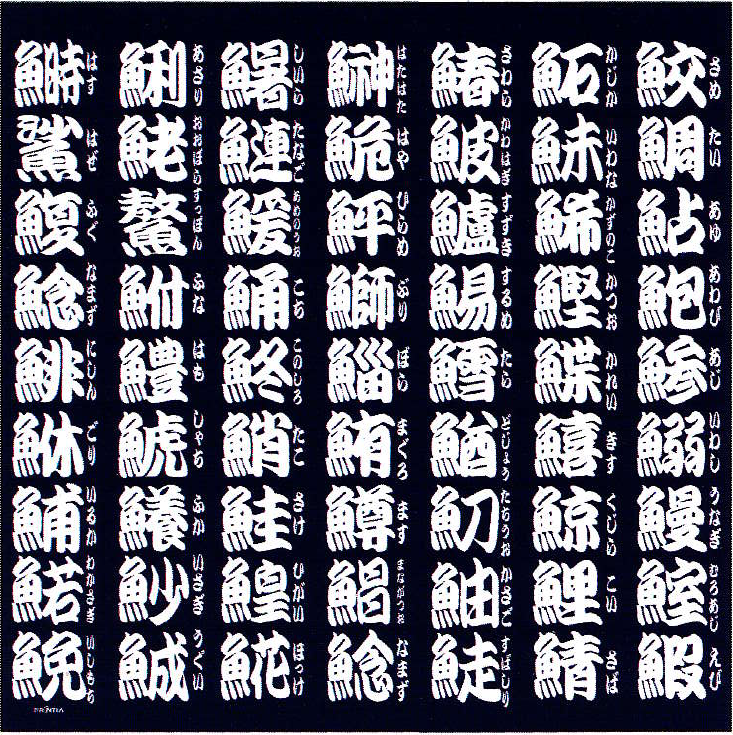Fish to the Left
I've been hanging out with Japanese couples. Last week I had an extremely stimulating, intellectual talk over tea with my newest proofreader and her husband.
Thursday I had lunch in the garden of a French restaurant with another new proofreader and his wife.
In each case, the spouse was visiting from Japan, and on both occasions I scored gifts with kanji on them. Though the presents were wonderful, the labels were the best part for me! Really, I'm not so different from a toddler who takes more interest in a cardboard box than in what it contains.
Thursday's gifts both had this theme:

That writing about a type of 漢字 (かんじ: kanji) comes from the label on a 湯呑み (ゆのみ: teacup), every bit of it covered with engravings of kanji representing types of fish. The following image should give you an idea of what I mean because it's a picture of the second present, a pack of paper napkins:

In this context, 偏 means "left-hand radical." Paired up with 魚 (さかな: fish), it produces 魚偏 (うおへん or さかなへん: "fish" radical on the left). Anyway, both the teacup and napkins abound in 魚偏漢字 (all of which are non-Joyo).
One of the first JOK pieces I wrote (back in February 2010, nearly two years before we launched!) was essay 1782 on 偏, which also means "one-sided, biased, inclined, partial." Back then I didn't have the slightest idea how to track down images with the kanji I needed. That essay contains two wonderful photos but none with 偏! How satisfying to see one all these years later!

Speaking of radicals, as I studied the labels on my lunchtime gifts, I noticed that two words shared a striking shape:
彫付 (ほりつけ: carving), the name of the teacup manufacturer
彩り (いろどり: coloring)
The latter term came on the napkin packaging in this sentence:
テーブルに彩りを添えるペーパーナプキン。
Paper napkins to add color to your table.
添える (そえる: to garnish, accompany)
What a lovely idea! But let's get back to those radicals!
In 彫 and 彩, the right side is radical 59, the "short hair" radical. It means "delicate hairs" in general, which is a little gross to contemplate in the context of teacups and napkins. But Henshall rescues us from the image of unwanted hair by saying what the radical really means in each situation:
彩 (1290: coloring, makeup, paint): The 彡 means "attractive adornment."
彫 (1590: to carve, sculpture): The 彡 means "delicate, attractive" and by extension "decorative, patterned."
Whew! We've left hairiness behind.
But I must say that I'm disappointed. Today, before I had a chance to consult Henshall, I dreamed about what those three neat strokes could represent. Knowing that the teacup has indented kanji, as if they've been carved, I hoped that 彡 symbolized a carver's signature, a controlled way of saying, "I was here, and I've left my mark on the world." Oh, well!
Speaking of carving, the HORITSUKE label kept sending my mind off in another wrong direction. Here's that label again:

I kept staring at 彫 and HORI, drawing a blank about the kanji's meaning while thinking of moats. That is, 堀 (canal, ditch, moat) also has the yomi of ほり. I knew 彫 had to represent something entirely different, as I had received a teacup, not a moat! Soon it came to me that 彫る (ほる) means "to carve" (as well as "to engrave, sculpt, chisel"). And I felt sure that there must be a connection between "digging" into a piece of porcelain and digging a trench. I mean, ほる must go way back in the native Japanese vocabulary, connecting both actions before kanji came along and differentiated them.
One final thing about the packaging. It contains this heading:

How charming, I thought when I looked up しおり (guidelines) and guessed the following: if 愛 is "love" and 用 is "use," these are guidelines for using the teacup lovingly! But no, 愛用 (あいよう) can mean "habitual use," so the instructions are for keeping the cup in tiptop shape even if you use it to the fullest.
I was foiled again! So much disappointment amid so much happiness! Well, that's kanji for you. All I can say is, use it lovingly!
Have a great weekend! And be sure to check the newest essay. Here's a preview:


Comments